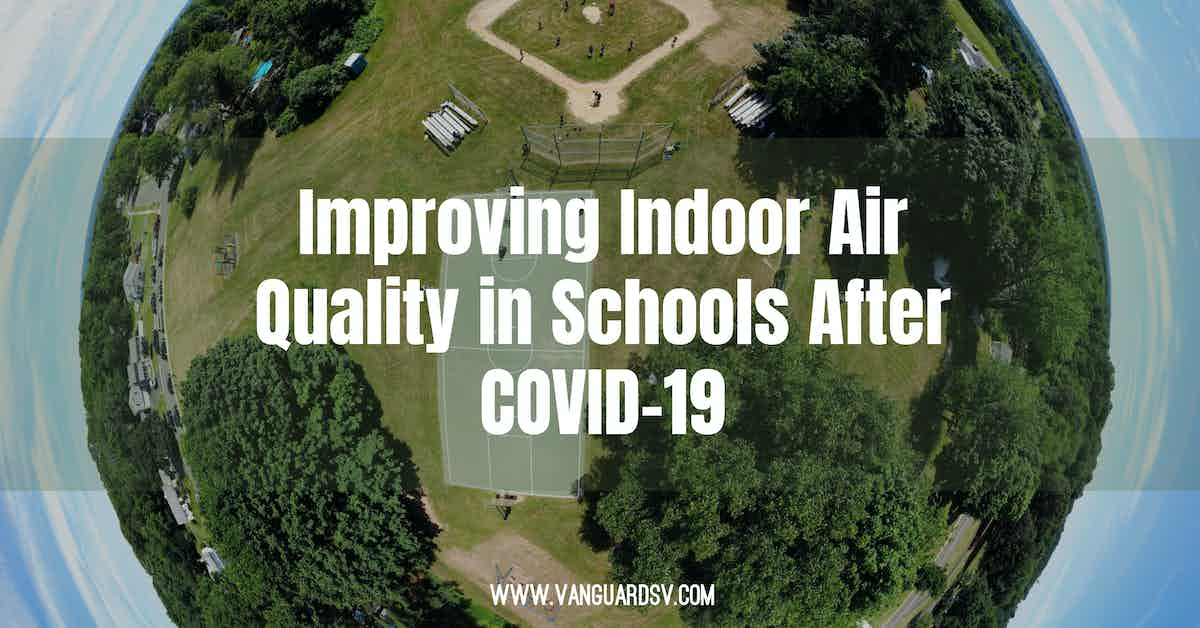The COVID-19 pandemic underscored the value of clean indoor air, especially in classrooms where indoor air quality (IAQ) plays a critical role in student's long-term success, health, and life outcomes.

The Post-COVID Demand for Clean Indoor Air Continues
Cleaning and disinfecting had minimal impact on the spread and transmission of SARS-CoV-2 and its variants.
According to a 2021 study published by the National Library of Medicine;
Using a quantitative risk assessment model, we simulated in a frozen food packaging facility 1) SARS-CoV-2 fomite-mediated infection risks following worker exposure to contaminated plastic packaging; and 2) reductions in these risks attributed to masking, handwashing, and vaccination.
Fomite-mediated SARS-CoV-2 infection risks were very low under cold-chain conditions.
Handwashing and masking provide significant protection to workers, especially when paired with vaccination.
Low risk of SARS-CoV-2 transmission via fomite, even in cold-chain
Evidence supporting the almost exclusive transmission of SARS-CoV-2 through the air includes:
- The long-range transmission and overdispersion of the pathogen are consistent with airborne transmission.
- Evidence demonstrates transmission between individuals in separate quarantined hotel rooms who were never in each other's presence.
- Asymptomatic and presymptomatic transmission rates from people not coughing or sneezing account for up to 59% of global spread.
- The pathogen's transmission rate is higher indoors than outside.
- Documented infections occurred in healthcare facilities with strict droplet, contact, and PPE precautions.
- Contagious microbes of SARS-CoV-2 have been detected in the air, and several experiments have demonstrated the pathogen can remain infectious when airborne for up three hours in a lab environment.
- SARS-CoV-2 has been detected in air filters and ducts.
- No substantial evidence exists refuting the airborne-dominant transmission hypothesis, and;
- Little evidence exists supporting fomite or droplet-dominant transmission theories.
Further, studies have demonstrated an association between high levels of indoor air pollution, which commonly result in respiratory infections, COPD, asthma, cardiovascular disease, and lung cancer, and more severe forms of SARS-CoV-2 infections.
According to Science Direct;
Air pollutants such as sulfur oxides, nitrogen oxides, carbon monoxide and dioxide, particulate matter (PM), ozone and volatile organic compounds (VOCs) are commonly found at high levels in big cities and/or in the vicinity of different chemical industries.
An association between air concentrations of these pollutants and human respiratory viruses interacting to adversely affect the respiratory system has been also reported.
The results of most studies [...] suggest that chronic exposure to certain air pollutants leads to more severe and lethal forms of COVID-19 and delays/complicates the recovery of patients of this disease.
Influence of airborne transmission of SARS-CoV-2 on COVID-19 pandemic. A review
How to Improve Indoor Air Quality in Education Facilities
From the information gathered, it is possible to conclude that improving indoor air quality will significantly reduce the transmission of SARS-CoV-2 and similarly spread pathogens and reduce or eliminate the source-cause of significant comorbidities that plague U.S. office workers, students, and the healthcare industry as a whole.
- Perform regular HVAC and air filter maintenance.
- Use natural ventilation where possible.
- Vaccum and mop daily.
- Remove rugs and carpeting.
- Use third-party tested and verified cleaning and disinfection products making low-emission and VOC-free claims.
- Avoid products containing formaldehyde, phthalates, or triclosan.
- Implement biophilic design and place live house plants, such as English Ivy or Sword Ferns, in the classroom, and;
- Install MERV-13 or higher HEPA filters in the HVAC system or install portable commercial-grade air cleaners in the classrooms.
References & Resources
- Ten scientific reasons in support of airborne transmission of SARS-CoV-2
- How to Improve Indoor Air Quality in Schools
Takeaway
Indoor air pollution represents significant health and social risks to U.S. citizens, especially children in classrooms where outdated air flow and filtration systems combined with low-quality cleaning programs, untrained custodial staff, insufficient resources, and outdated equipment result in a staggering number of occupant respiratory issues and attendance challenges.
Further, mounting evidence suggests a strong correlation between chronic occupant exposure to indoor pollutants and increased SARS-CoV-2 recovery time and mortality.
Improving classroom air quality decreases occupant exposure to toxins and related infections, resulting in few absences, better student performance, and a stronger probability of graduating high school.
Onboarding the requisite material resources and skilled labor to ensure high-level outcomes may prove cost-prohibitive for many school districts struggling with funding challenges.
Outsourcing is a proven method for onboarding highly in-demand cleaning and disinfection services and experience for a fraction of the price of maintaining a similar service in-house.
If you would like more information regarding the effectiveness of high-performance infection prevention and control measures, or if you would like to schedule a free, no-obligation on-site assessment of your facility's custodial needs, contact us today for a free quote!
In Bakersfield, CA, call (661) 437-3253
In Fresno, CA, call (559) 206-1059
In Valencia, CA, or Santa Clarita, CA, call (661) 437-3253
In Palmdale, CA, or Lancaster, CA, call (661) 371-4756

